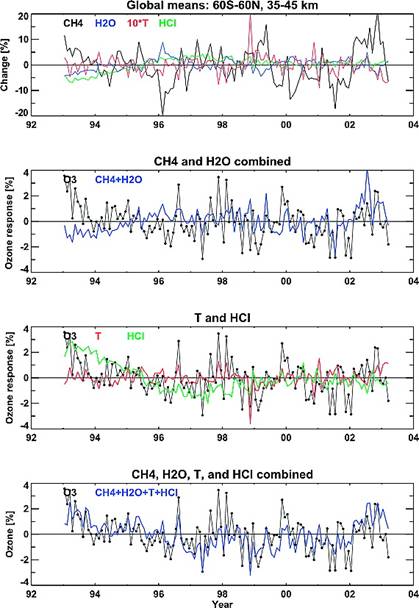40km
Ozone Recovery
Newchurch
M. J., E.-S. Yang, D. M. Cunnold, G. C. Reinsel,
J. M. Zawodny, J. M. Russell III, Evidence for
slowdown in stratospheric ozone loss: First stage
of ozone recovery, J. Geophys. Res., 108 (D16),
4507, doi:10.1029/2003JD003471, 2003. Full
Text
Global ozone trends
collected by SAGE I/II along with HALOE provide evidence
of a slowdown in stratospheric ozone loss since 1997. Changes
in the loss of HCl and several other ozone precursors
in the upper stratosphere are indicative of the first
stages of ozone recovery in the upper stratosphere
and the ozone layer.

Figure 5.
Coupling of CH4, H2O, and T with ozone at 35–45
km, 60°S–60°N. First panel: HALOE
monthly averages for CH4, H2O, T, and HCl residuals
plus trend in percent. The seasonal, solar, and
QBO effects are subtracted from the original CH4,
H2O, T, and HCl observations, respectively. Note
that the vertical scale for T is 10 times larger.
Second panel: combined CH4 and H2O impacts on ozone
(blue line), which are empirically estimated from
the regression analysis. For comparison, ozone
trend plus residuals are shown with a black line.
Third panel: estimated influence of T on ozone
(red line) and ozone change corresponding to HCl
variations (green line). HCl is selected as a proxy
for stratospheric CFC. Fourth panel: observed ozone
residuals plus trend (black line) compared to estimated
ozone residuals plus trend by CH4/H2O/T/HCl impacts
on ozone (blue line).
The above figure
provides visual evidence of the effects of the Montreal
Protocol at decreasing the amount of several ozone
precursors in the upper stratosphere. With
these ozone precursors on the decline, the first
stage of ozone recovery in the upper stratosphere.
|